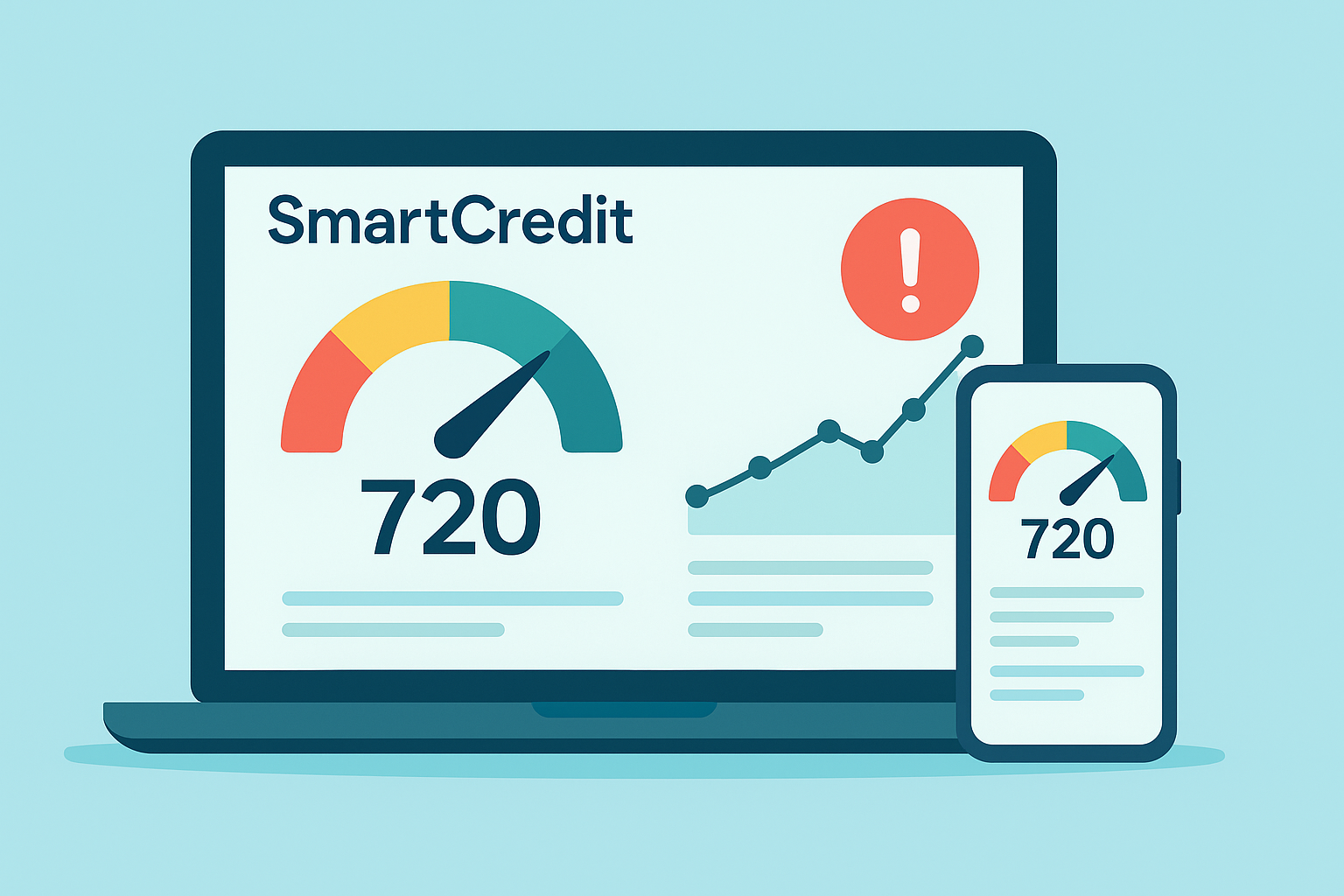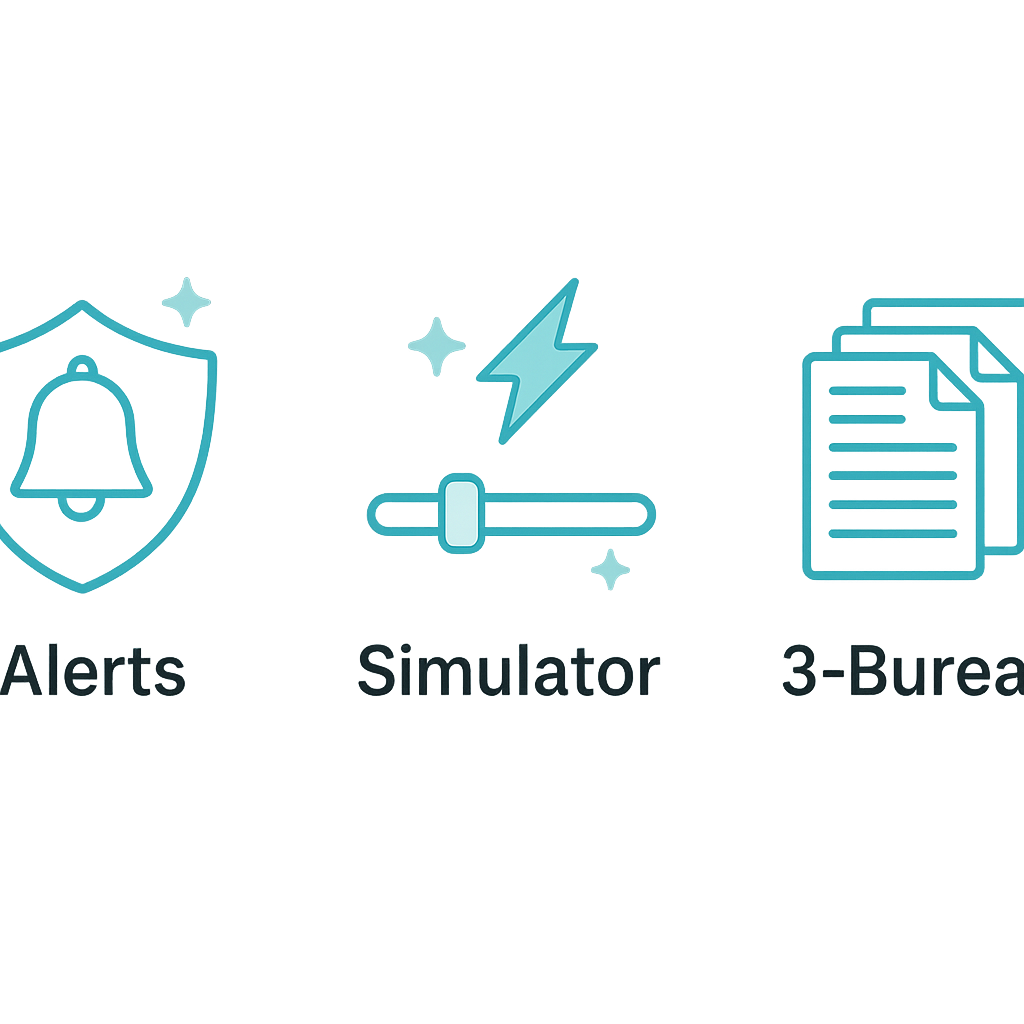Disclosure: We may earn a commission when you click links on this page. This does not increase your cost.
SmartCredit®: Try It for 7 Days for Just $1 — Monitor Your Credit, Catch Identity Threats Early, and Plan a Smarter Score

Fast signup. Easy to cancel. See if SmartCredit is right for you.
Your credit score is one of the most powerful numbers in American life. It can influence the credit cards you’re approved for, the interest rate you pay on a car or a mortgage, and—in some cases—insurance premiums or access to certain apartments. The trouble is, credit data isn’t static. It shifts when you make payments, carry balances, open new accounts, or when a lender pulls your report. And if a bad actor gets hold of your information, fraudulent accounts could appear under your name before you notice. The result: higher costs, declined applications, and months of cleanup.
SmartCredit® aims to solve the “I wish I had known sooner” problem. It monitors your credit activity, sends timely alerts, and provides a dashboard that helps you understand what’s moving your score. Most uniquely, SmartCredit offers “what-if” style simulators that estimate the potential impact of your next move—paying down a balance, increasing a limit, or closing an account—before you commit. With a $1 trial for seven days, it’s an inexpensive test drive to see if the monitoring, tools, and guidance fit your goals this month, this quarter, and beyond.
What You Actually Get — Beyond a Generic “Credit Score App”
Plenty of apps show a score. Fewer help you manage it. SmartCredit’s value is the combination of monitoring, context, and actionability. Monitoring means you aren’t blindsided by new inquiries or accounts. Context means you see why the score looks the way it does (payment history, utilization, age of accounts, mix, and new credit). Actionability is the hard part most tools skip—estimating how specific choices might affect your score and pointing you toward steps that move the needle in the real world.
- Timely alerts: Get notified about new accounts, inquiries, major balance or limit changes, address updates, and other credit events that deserve attention.
- Readable breakdowns: See the drivers behind your score without wading through jargon. You’ll quickly identify root causes and easy wins.
- “What-if” simulators: Test scenarios before acting—how much might paying down Card A change your utilization and potential score band? Should you request a limit increase on Card B? Would closing an old card hurt?
- Multi-bureau visibility: A single source rarely tells the whole story. Cross-checking bureaus helps you spot discrepancies and dispute errors sooner.
- Guided dispute center: When something looks off, you can follow step-by-step guidance to address it with the right documentation and follow-through.
- Clean web + mobile dashboard: Built for decisions, not just curiosity. The UI keeps the next best action in view.

Who Should Consider the $1 Trial?
If you’re about to apply for credit, want to lift your score over a key threshold, or you just prefer to keep a close eye on identity risk, the seven-day trial is a simple, low-cost check. The sweet spot is anyone who wants to turn a vague “I hope my score is okay” into a concrete plan:
- Pre-application planners: People preparing for a mortgage, auto loan, or new card who want to catch avoidable dings before applying.
- Short-term score builders (1–3 months): Those who want to prioritize actions with the biggest potential impact.
- Identity-aware consumers: Anyone who’s experienced a data breach or simply wants early warnings if something changes.
- DIY financial managers: People who like to see their numbers, simulate options, and measure progress.
Three Practical Scenarios Where SmartCredit Shines
1) Before You Apply for New Credit
Timing matters. If your revolving utilization is high, paying down the right card can move your score band faster than you expect. Likewise, spacing out hard inquiries can keep you from looking “credit hungry.” With SmartCredit’s tools, you can identify which balances are dragging you down and run simulations to estimate lift before you pull the trigger. That way you submit applications at your strongest moment.
2) Responding to Suspicious Activity Immediately
A new account you didn’t open? An inquiry out of nowhere? Alerts help you respond within days, not months. You can freeze credit with the bureaus, file disputes with supporting documents, and track progress. The faster you act, the less cleanup later.
3) Negotiating a Better Rate by Crossing a Threshold
Many lenders use broad score ranges to determine pricing. Nudging your score across a line—say from the high-600s into the 700s—can change your rate tier. The simulator gives you a directional estimate of which steps (paying down, increasing limits, correcting errors) are most likely to get you there in the time you have.
How to Start Your 7-Day Trial (Takes About 5–10 Minutes)
- Click the $1 Trial button on this page to go to SmartCredit’s official signup.
- Create your account and complete identity verification. Those security questions protect your records from unauthorized access.
- Turn on alerts for new accounts, inquiries, limit changes, and late payments. Explore the dashboard sections for Alerts, Score, Reports, and the Simulators.
Once you’re in, set one or two concrete goals for the week. For example: “Reduce total utilization below 20%” or “Dispute the incorrect late mark on the store card.” A focused, measurable goal turns exploration into progress.
Tips to Get the Most Value from the Trial Week
- Set a reminder: If you only want to evaluate, add a calendar nudge a day or two before the trial ends so you can decide to continue or cancel.
- Audit for errors: Compare bureau data, look for outdated accounts or balances, and initiate disputes where needed.
- Prioritize utilization: Bringing revolving utilization below 30% (and ideally under 10–20% before an application) can be a fast, meaningful win.
- Use the simulator seriously: Plug in the exact balances and actions you’re considering. Treat the results as directional guidance to rank your to-dos.
- Mind your inquiries: If you’ve had several recent pulls, consider spacing the next application to avoid compounding impact.
- Hygiene matters: Enable MFA, use strong passwords, avoid public Wi-Fi for financial logins, and watch for phishing—alerts help, but habits protect you too.

How SmartCredit Compares to Common Alternatives
Pulling your free reports from AnnualCreditReport.gov gives you transparency, but it’s a snapshot, not a monitor—and there’s no simulator. Many banks and finance apps display a score for free, but coverage can be limited and alerts uneven. A number of identity-protection services focus on insurance in case of identity theft; that’s helpful, but doesn’t replace proactive monitoring and score planning. SmartCredit’s niche is actionable monitoring plus those “what-if” tools that help you plan near-term improvements with fewer surprises.
What the Simulators Can and Can’t Do
No simulator can predict your exact score next Tuesday. Models differ, bureaus update on their own schedules, and lenders may use proprietary criteria. Treat simulations as a compass, not a guarantee. Their power is in ranking your options: if paying $500 on Card A appears to move the needle more than $500 on Card B, you’ve learned something that guides action today. Combine that with alerts and disciplined habits—on-time payments, low utilization, and minimal new accounts—and you’ll stack the odds in your favor over the next 30–90 days.
A 30-Day Game Plan You Can Steal
The goal here isn’t perfection; it’s momentum. Use this template to convert the seven-day trial into outcomes you’ll still appreciate next month:
- Days 1–3: Turn on alerts. Review each bureau for errors or outdated info. Write down your baseline score(s) and utilization by card.
- Days 4–10: Execute the highest-leverage payoff(s) first. Ask for a limit increase on a well-managed card if the simulator suggests a positive impact (and if your lender allows soft-pull CLIs).
- Days 11–20: Track confirmations and updates. Keep balances trending down and avoid unnecessary applications while you’re optimizing.
- Days 21–30: Re-evaluate your position. If ongoing monitoring and simulations are still helpful, continue; if not, set calendar reminders to pull free snapshots periodically.
Frequently Asked Questions
Will I be charged after the 7-day trial?
Are the “what-if” simulators 100% precise?
Can SmartCredit remove negative items for me?
Is my data safe?
What if I’m already getting a free score from my bank?
See Your Credit Clearly — and Act with Confidence
Whether you’re prepping for an application or just want proactive protection, one focused week can pay off. You’ll benchmark where you stand, catch issues early, and test your options with fewer surprises. The point isn’t to obsess—it’s to make smarter moves with less guesswork.